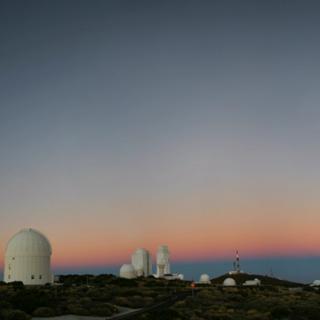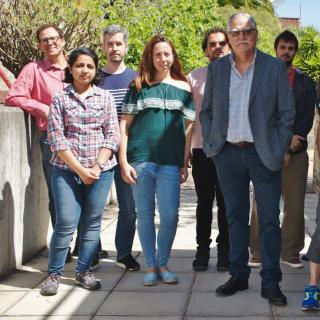General
Este proyecto mantiene dos líneas principales de investigación activas:
1) Estudio de la estructura, condiciones físicas y composición química de las nebulosas ionizadas, tanto galácticas como extragalácticas, a través del análisis detallado y modelización de sus espectros. Investigación de los gradientes de composición química a lo largo del disco de nuestra galaxia y en galaxias cercanas.
2) Determinar las condiciones físico-químicas de las nebulosas planetarias galácticas con geometría bipolar y de las nebulosas alrededor de estrellas simbióticas. El fin es entender el origen de la bipolaridad y poner a prueba los modelos teóricos que intentan explicar la morfología y la cinemática nebular, con especial énfasis en los modelos con estrellas binarias centrales. Estudiaremos también las implicaciones de la evolución de los sistemas binarios en otros escenarios astrofísicos, como la formación de jets, las variables cataclismicas y las explosiones de tipo nova y supernova
Miembros
Resultados
- Usando espectros en el rango infrarojo cercano obtenidos con EMIR/GTC, se han detectado por primera vez líneas de emisión de telurio y bromo en dos nebulosas planetarias. Estas son detecciones de elementos pesados en uno de los lugares en dónde se forman, nos dan información sobre el patrón de abundancias de elementos pesados debido al proceso-r y al proceso-s.
Actividad científica
Publicaciones relacionadas
-
Properties of the ionized gas in HH 202 - II. Results from echelle spectrophotometry with Ultraviolet Visual Echelle Spectrograph
We present results of deep echelle spectrophotometry of the brightest knot of the Herbig-Haro object HH 202 in the Orion Nebula - HH 202-S - using the Ultraviolet Visual Echelle Spectrograph in the spectral range from 3100 to 10400 Å. The high spectral resolution of the observations has permitted to separate the component associated with the
Mesa-Delgado, A. et al.Fecha de publicación:
52009 -
Massive star formation in Wolf-Rayet galaxies. IV. Colours, chemical-composition analysis and metallicity-luminosity relations
Aims: We have performed a comprehensive multiwavelength analysis of a sample of 20 starburst galaxies that show a substantial population of very young massive stars, most of them classified as Wolf-Rayet (WR) galaxies. In this paper, the forth of the series, we present the global analysis of the derived photometric and chemical properties. Methods
López-Sánchez, Á. R. et al.Fecha de publicación:
72010 -
Massive star formation in Wolf-Rayet galaxies. III. Analysis of the O and WR populations
Aims: We perform a comprehensive multiwavelength analysis of a sample of 20 starburst galaxies that show a substantial population of Wolf-Rayet (WR) stars. In this paper, the third of the series, we present the analysis of the O and WR star populations within these galaxies. Methods: We study the spatial localization of the WR-rich clusters via the
López-Sánchez, Á. R. et al.Fecha de publicación:
62010 -
Massive star formation in Wolf-Rayet galaxies. II. Optical spectroscopy results
Aims. We have performed a comprehensive multiwavelength analysis of a sample of 20 starburst galaxies that show the presence of a substantial population of very young massive stars, most of them classified as Wolf-Rayet (WR) galaxies. In this paper, the second of the series, we present the results of the analysis of long-slit intermediate
López-Sánchez, A. R. et al.Fecha de publicación:
122009 -
Massive star formation in Wolf-Rayet galaxies. I. Optical and NIR photometric results
Aims: We have performed a comprehensive multiwavelength analysis of a sample of 20 starburst galaxies that show the presence of a substantial population of massive stars. The main aims are the study of the massive star formation and stellar populations in these galaxies, and the role that interactions with or between dwarf galaxies and/or low
López-Sánchez, Á. R. et al.Fecha de publicación:
112008 -
M1-78: a nitrogen-rich Galactic compact H II region beyond the Perseus arm
Context: There is considerable controversy surrounding the nature of M1-78, a compact nebula located beyond the Perseus arm. It was first classified as a planetary nebula and is nowadays generally considered to be a compact H II region. Aims: To investigate the nature of M1-78 further, we present a detailed spectroscopic study of M1-78 in the
Martín-Hernández, N. L. et al.Fecha de publicación:
42008 -
Keck HIRES Spectroscopy of Extragalactic H II Regions: C and O Abundances from Recombination Lines
We present very deep spectrophotometry of 14 bright extragalactic H II regions belonging to spiral, irregular, and blue compact galaxies. The data for 13 objects were taken with the High Resolution Echelle Spectrometer on the Keck I telescope. We have measured C II recombination lines in 10 of the objects and O II recombination lines in eight of
Esteban, César et al.Fecha de publicación:
72009 -
Ionized gas diagnostics from protoplanetary discs in the Orion nebula and the abundance discrepancy problem
We present results from integral field spectroscopy of a field located near the Trapezium Cluster using the Potsdam Multi-Aperture Spectrophotometer (PMAS). The observed field contains a variety of morphological structures: five externally ionized protoplanetary discs (also known as proplyds), the high-velocity jet HH 514 and a bowshock. Spatial
Mesa-Delgado, A. et al.Fecha de publicación:
102012 -
Integral field spectroscopy of selected areas of the Bright bar and Orion-S cloud in the Orion nebula
We present integral field spectroscopy of two selected zones in the Orion nebula obtained with the Potsdam Multi-Aperture Spectrophotometer, covering the optical spectral range from 3500 to 7200 Å and with a spatial resolution of 1 arcsec. The observed zones are located on the prominent Bright bar and on the brightest area at the north-east of the
Mesa-Delgado, A. et al.Fecha de publicación:
102011 -
Exploring the effects of high-velocity flows in abundance determinations in H II regions: bidimensional spectroscopy of HH 204 in the Orion nebula
We present results from integral field optical spectroscopy with the Potsdam Multi-Aperture Spectrograph of the Herbig-Haro (HH) object HH 204, with a spatial sampling of 1 × 1 arcsec2. We have obtained maps of different emission lines, physical conditions and ionic abundances from collisionally excited lines. The ionization structure of the object
Núñez-Díaz, M. et al.Fecha de publicación:
42012 -
A detailed study of the H ii region M 43 and its ionizing star
Aims: We have selected the Galactic H ii region M 43, a close-by apparently spherical nebula ionized by a single star (HD 37061, B0.5 V) to investigate several topics of recent interest in the field of H ii regions and massive stars. In a series of two papers, we perform a combined, comprehensive study of the nebula and its ionizing star by using
Simón-Díaz, S. et al.Fecha de publicación:
62011
![Izquierda - Imagen RGB de la nebulosa de Orión y M43 obtenida filtros estrechos con la cámara WFC en el INT: H alfa (rojo), [S II] 6716+30 (verde), [O III] 5007 (azul). Derecha - Imagen en falso color de la nebulosa planetaria NGC 6778. En azul se ve la emisión en la línea de O II tomada con el filtro sintonizable azul del instrumento OSIRIS en el GTC; en verde imagen con el filtro estrecho de [O III] del Nordic Optical Telescope (NOT). Izquierda - Imagen RGB de la nebulosa de Orión y M43 obtenida filtros estrechos con la cámara WFC en el INT: H alfa (rojo), [S II] 6716+30 (verde), [O III] 5007 (azul). Derecha - Imagen en falso color de la nebulosa planetaria NGC 6778. En azul se ve la emisión en la línea de O II tomada con el filtro sintonizable azul del instrumento OSIRIS en el GTC; en verde imagen con el filtro estrecho de [O III] del Nordic Optical Telescope (NOT).](/sites/default/files/styles/crop_rectangle_21x9_to_1280/public/images/project/imagen_web.jpg?itok=_CZ-LRtm)


